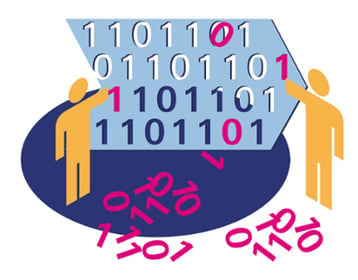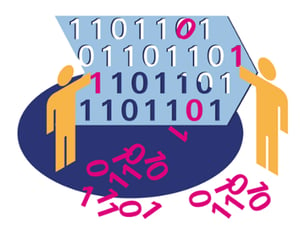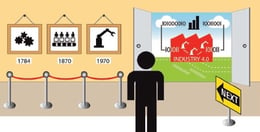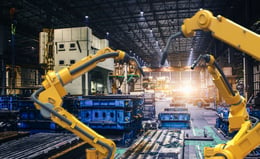What Industry 4.0 Will Mean for Your Planning Workflows
Brian Hoey - September 04, 2018

 Imagine you own and operate a pin factory at the dawn of the Industrial Revolution. One day, you come in and announce to your workers that you’ll be implementing steam powered machinery into your production processes, completely reimagining many existing workflows in the process. How do you think your employees, especially those involved in planning out production workflows, are likely to react? Some of them might be excited or intrigued, certainly, but many others are likely to meet the news with apprehension or even distrust. After all, they were doing just fine making pins by hand all this time.
Imagine you own and operate a pin factory at the dawn of the Industrial Revolution. One day, you come in and announce to your workers that you’ll be implementing steam powered machinery into your production processes, completely reimagining many existing workflows in the process. How do you think your employees, especially those involved in planning out production workflows, are likely to react? Some of them might be excited or intrigued, certainly, but many others are likely to meet the news with apprehension or even distrust. After all, they were doing just fine making pins by hand all this time.
More than a reaction to fear of change, it’s likely that your employees would be concerned due to a lack of knowledge. Many of the people whose lives are about to be altered by this new technology have likely never seen steam power in action. As a result they can’t envision creating effective plans in a radically altered production environment. In the world of Industry 4.0 manufacturing, and automotive manufacturing in particular, there’s a similar lack of education, and it’s leading to similar anxieties about potential planning workflows changes. To wit, as of a few years ago only 25% of manufacturers in a UK-based survey felt that they understood the implication and opportunities presented by Industry 4.0.
Visibility as a Time-saving Tool
Much like early steam-powered machinery, the interconnected array of cyber-physical systems that comprise Industry 4.0 will change the way that people work. Just as the first Industrial Revolution led to exponential increases in productivity and a larger industrial workforce, the Industry 4.0 revolution will be aimed at giving humans the tools they need to do their jobs at an increased level of efficiency and optimization. One of the most important ways in which this boost in efficiency is accomplished is through increased visibility via digitization. For instance, modern auto manufacturers might leverage internet of things (IoT) devices to create real-time, digital twins of their operations for the purpose of running simulations and what-if scenarios. The digital nature of this process should lead to a reduction in planning and decision-making silos. For businesses as a whole, this might mean a more agile, responsive value stream—but for planners themselves the upshot would be greater access to mission critical information, to say nothing of the ability to test out hypothetical workflow changes in a simulated environment.
As a result, a production planner in a company’s Stuttgart office could effectively visualize and understanding production workflows that were occurring halfway around the world in a Mexico-based factory. As changes to factory processes occurred, the planner in Germany could assess potential bottlenecks and suggest process improvements, as well as responding to slowdowns or disruptions as they happen. This way, a hypothetical parts shortage in North America could be met with an instantaneous response—say, altering production ratios in another production facility in order to alleviate the pressure on the Mexican factory.
The Power of Integration
Of course, some of the hallmarks of Industry 4.0 systems are machine-to-machine communication and advanced technological integration, which represent steps that can be taken beyond digitization in order to empower more robust, efficient planning workflows. Real-time supply chain information, autonomous inventory ordering processes, and Postmodern ERP systems all contribute to an industrial environment that streamlines the efforts of human planners.
By gaining access to, say, sequencing information, customer delivery requirements, and real-time demand for particular parts, for instance, planners can gain a more holistic, cohesive picture of the company’s overall value chain, and can then make decisions accordingly. Imagine that a planner received an alert from an IoT device on the factory floor suggesting that a machine breakdown was probable in the near future, based on an algorithm designed to predict maintenance downtime in advance. In an integrative environment, that planner could take a proactive approach to scheduling machine maintenance that accounted not just for the minimization of impact on factory floor operations, but on transport routing, delivery windows, and a host of other interrelated complexities. The result is that businesses can begin to optimize their value chains in ways that would have been impossible even ten years ago.
Collaboration 4.0
Though most of the evolutions described up to this point have been technological, some of the most important changes to planning and production workflows will be conceptual. Thanks to Industry 4.0’s technological underpinnings, the sharp divisions between strategic, tactical, and operational planning will be erased, giving rise to one continuous, collaborative planning funnel. With the rise of real-time supply chain information and the reduction of information silos, different stages of the planning process can be done in parallel, with changes in resource or time usage being reflected immediately throughout a given operation. Thus, in addition to being informed by up-to-the-minute supply chain data, all planning functions can operate in constant conversation with one another, leading to new opportunities to collaborate and to add value through synergy.
While the workers at your pin factory might have had some doubts about the technology of the first Industrial Revolution, your production planners, as they become educated, should look forward to a new and exciting environment as a result of the fourth Industrial Revolution. Without it, they’ll be stuck grappling with the familiar disconnect that arises between short-, medium-, and long-term plans, each one struggling to adapt to the other two as changes unfold in the market or within one’s own organization. They’ll be limited by silos and stuck with outdated information, rather than being empowered to optimize their processes through integration and collaboration.
LATEST POSTS
- Understand Circular Economy in The Manufacturing Industry
- How Can Industry 4.0 IT Integration Be Achieved Smoothly?
- The Significance of Order Sequencing in Discrete Manufacturing
- How to improve your Supply Chain Management: The Power of Control Towers
- Optimizing Human Resource Scheduling in Manufacturing: A Technological Approach



